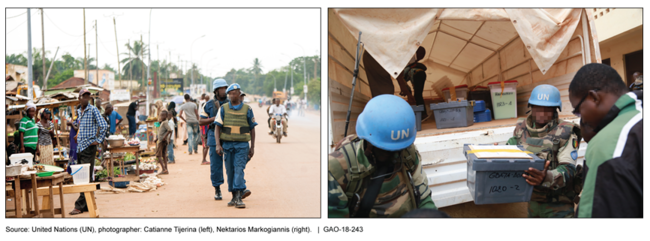UN Peacekeeping: Cost Estimate for Hypothetical U.S. Operation Exceeds Actual Costs for Comparable UN Operation
Fast Facts
The UN reported a cost of about $2.4 billion to carry out 39 months of peacekeeping operations in the Central African Republic.
What if the U.S. had carried out that operation instead? How might costs differ?
We estimated it would have cost the U.S. more than twice as much, nearly $5.7 billion, to carry out a comparable operation. Higher U.S. costs would result from higher standards for facilities, intelligence, and medical services, and greater airlifting of supplies and equipment.
We also found that while U.S. peacekeeping operations would have greater military capability, the UN would have greater international acceptance.
UN peacekeepers at work in Bangui, the capital of the Central African Republic

Photos show peacekeepers walking down the street and unloading a truck.
Highlights
What GAO Found
Based on United Nations (UN) and Departments of Defense (DOD) and State (State) data, GAO estimates that it would cost the United States more than twice as much as it would cost the UN to implement a hypothetical operation comparable to the UN Multidimensional Integrated Stabilization Mission in the Central African Republic (MINUSCA). MINUSCA cost the UN approximately $2.4 billion for the first 39 months of the operation. GAO estimates that a hypothetical U.S. peacekeeping operation in the Central African Republic of roughly the same size and duration would cost nearly $5.7 billion—almost eight times more than the $700 million the United States contributed to MINUSCA over the same time period.
Comparison of U.S. Contribution to MINUSCA, UN Cost for MINUSCA, and Estimated Cost of a Hypothetical U.S. Peacekeeping Operation in the Central African Republic, April 2014 through June 2017

Various factors affect differences between the actual cost of MINUSCA and the estimated cost of a hypothetical, comparable U.S. operation in the Central African Republic. The United States and the UN would source and transport some supplies and equipment differently, affecting the cost of both operations; for example, the United States would airlift water into the Central African Republic, while the UN does not do so to the same extent. The United States also would incur the cost of civilian police and military reservist salaries, while the UN does not pay any troop or police salaries. Finally, some higher standards for facilities, intelligence, and medical services increase the U.S. cost estimate relative to UN costs for similar operational elements.
UN and U.S. peacekeeping operations have various relative strengths, according to U.S. and UN officials. These officials said that, because the UN is a multilateral organization, UN peacekeeping operations have international acceptance and are more likely to be viewed as impartial. Officials also said that the UN enjoys global access to expertise and experience, and can leverage assistance from multilateral donors and development banks. Relative strengths of a U.S. peacekeeping operation would include faster deployment and superior command and control, logistics, intelligence, and counterterrorism capability, according to U.S. and UN officials.
Why GAO Did This Study
To promote international peace and security, the UN had 16 ongoing peacekeeping operations worldwide as of June 30, 2017, with a total budget of almost $8 billion in UN fiscal year 2017 and contributions of over 100,000 military, police, and civilian personnel from more than 120 countries. The United States is the largest financial contributor to UN peacekeeping operations, providing an average of about 28 percent of total funding annually.
The Department of State Authorities Act, Fiscal Year 2017, includes a provision for GAO to compare the costs, strengths, and limitations of UN and U.S. peacekeeping operations. This report (1) compares the reported costs of a specific UN operation to the estimated costs of a hypothetical, comparable operation implemented by the United States; (2) identifies factors that affect cost differences; and (3) identifies stakeholder views on the relative strengths of UN and U.S. peacekeeping operations.
GAO worked with the UN, DOD, and State to generate a cost estimate of a hypothetical U.S.-led operation in the Central African Republic comparable to MINUSCA. GAO developed this estimate using DOD's cost estimating tool for contingency operations and State data on civilian costs, assuming a U.S. operation using roughly the same levels of military and civilian personnel as MINUSCA. The cost estimate should not be construed as suggesting that the United States would likely implement such an operation in the Central African Republic or that it would implement such an operation in the same way.
GAO is making no recommendations.
For more information, contact Thomas Melito at (202) 512-9601 or melitot@gao.gov.
